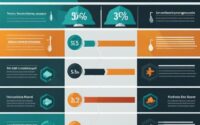Are You Making The Most Of CTR For SEO Success?
Overlooking Click-Through Rate (CTR) could be hindering your SEO success. Understanding how CTR impacts your search engine rankings is crucial. By optimizing your meta titles and descriptions to increase clicks, you can boost your organic traffic significantly. Learn how to leverage CTR for SEO success and watch your rankings soar.
Key Takeaways:
- CTR is a crucial ranking factor: Click-through rate (CTR) is an important metric that search engines use to determine the relevance and quality of your website.
- Optimize meta titles and descriptions: Crafting compelling meta titles and descriptions can increase your CTR, leading to improved SEO performance.
- Focus on user intent: Understanding user intent and tailoring your content to meet their needs can boost CTR and SEO rankings.
- Use engaging and relevant keywords: Incorporating relevant keywords in your titles and descriptions can attract the right audience and improve CTR.
- Utilize schema markup: Implementing schema markup can enhance the visibility of your search results, increasing the likelihood of clicks.
- A/B test your titles and descriptions: Experimenting with different variations of your titles and descriptions can help you identify the most effective ones for higher CTR.
- Monitor and analyze CTR performance: Regularly tracking and analyzing your CTR metrics can provide valuable insights for refining your SEO strategy and improving overall performance.
The Importance of CTR in SEO
How CTR Affects Search Engine Rankings
Your Click-Through Rate (CTR) is a crucial metric that search engines like Google use to determine the relevance and quality of your website. Any search result that garners more clicks is seen as more valuable and is likely to climb higher in the search engine rankings. This means that optimizing your meta titles and descriptions to entice users to click through to your website can have a significant impact on your SEO success.
The Role of User Experience in CTR
Rankings rely heavily on user experience metrics, with CTR being a key indicator. If users consistently click on your website in search results but quickly bounce back to the search page, this can signal to search engines that your content is not meeting user expectations and could lead to a drop in rankings. It’s crucial to pair a high CTR with engaging and valuable content to keep users on your site and improve your SEO performance.
It’s crucial to remember that CTR is not just about getting users to click through to your site – it’s also about providing an excellent user experience once they land on your page. By focusing on creating compelling meta titles and descriptions, as well as delivering valuable content that keeps users engaged, you can improve your CTR and boost your search engine rankings in the process.

Identifying Opportunities for Improvement
Analyzing Your Website’s Current CTR
For little adjustments that can lead to significant SEO improvements, start by analyzing your website’s current click-through rate (CTR). This data can provide crucial insights into the effectiveness of your meta titles and descriptions. Consider using tools like Google Search Console to identify pages with lower CTRs.
Pinpointing Pages with Low CTR
With the data in hand, you can pinpoint pages with low CTRs and prioritize them for optimization. Look for patterns or commonalities among these pages; it could be poor meta tags, unengaging content, or misleading titles. By focusing your efforts on these specific areas, you can make targeted improvements that have a direct impact on your SEO performance.
Another way to identify opportunities for improvement is to compare your CTR with industry benchmarks. If your CTR is significantly below average for your industry, it may indicate that there are substantial opportunities to enhance your meta tags, improve your content quality, or reposition your keywords strategically.

Optimizing Title Tags and Meta Descriptions
Crafting Compelling Title Tags
Tags: Craft your title tags with care, as they are the first thing users see on search engine results pages. Make sure your title tags are concise, descriptive, and engaging. You want to entice users to click through to your website, so include relevant keywords that reflect the content on the page.
Writing Effective Meta Descriptions
Compelling: Meta descriptions are like a sneak peek into what users can expect from your webpage. Use this space to compel users to click through by highlighting the value they will gain from visiting your site. Keep your meta descriptions under 160 characters to ensure they display properly in search results.
This is your opportunity to differentiate your site from the competition and drive traffic by enticing users to choose your link over others on the search results page.
Best Practices for Title Tag and Meta Description Length
Tags: Title tags should ideally be between 50-60 characters to ensure they display fully in search results. Meta descriptions should be under 160 characters to avoid truncation. Concise and informative lengths are key to catching the user’s attention and encouraging them to click through to your website.
Title: By following best practices for title tag and meta description length, you can optimize your click-through rate (CTR) and improve your site’s visibility in search engine results. Keeping your tags within the recommended character limits ensures that your content appears as intended and increases the likelihood of users clicking on your website.
Enhancing User Experience for Higher CTR
Improving Page Load Speed
Experience lightning-fast page load speeds to enhance user satisfaction and boost your site’s SEO performance. Slow-loading pages are a major turnoff for users, leading to higher bounce rates and lower CTR. Consider optimizing images, leveraging browser caching, and minifying CSS and JavaScript to speed up your website.
Enhancing Mobile Responsiveness
An engaging mobile-responsive design is crucial for improving CTR as more users browse on mobile devices. Ensure your site is visually appealing and easy to navigate on smartphones and tablets. Utilize responsive design principles to enhance the user experience across all devices.
Speed is of the essence when it comes to mobile responsiveness. Mobile users expect quick and seamless interactions, so prioritize a mobile-optimized experience to keep them engaged and drive higher CTR.
Streamlining Content for Easy Scanning
For CTRs that soar, optimize your content for easy scanning. Break up text into digestible chunks, use descriptive subheadings, and incorporate bullet points and numbered lists to make information more accessible. By enhancing readability, you can increase user engagement and CTR.
Enhancing the readability of your content not only improves the user experience but also makes your site more attractive to search engines. By organizing information effectively, you can capture the attention of users and boost your site’s SEO performance.
Leveraging Keywords for Better CTR
Conducting Keyword Research for CTR Optimization
Keep in mind that keywords play a crucial role in improving your Click-Through Rate (CTR). To optimize your CTR, start by conducting thorough keyword research. Identify high-volume, relevant keywords that your target audience is likely to use when searching for content like yours. Tools like Google Keyword Planner, SEMrush, or Ahrefs can help you discover the best keywords to target.
Strategic Keyword Placement for Maximum Impact
Leveraging strategic keyword placement is necessary for maximum impact. Ensure that your target keywords are prominently featured in your page titles, meta descriptions, headers, and within the body content. By strategically placing these keywords throughout your content, you increase the chances of your pages appearing in relevant search results, ultimately boosting your CTR.
Keywords should be seamlessly incorporated into your content to improve relevancy and visibility. Balancing keywords naturally within your content is key to engaging both search engines and your audience. Avoid keyword stuffing, as this can harm your SEO efforts and turn off readers.

Measuring and Tracking CTR Progress
Setting Up Google Analytics for CTR Tracking
For successful SEO, it is vital to monitor your Click-Through Rate (CTR) over time. One way to do this is by setting up Google Analytics to track your CTR progress. By linking your website to Google Analytics, you can access valuable data on your website’s performance, including CTR metrics.
On your Google Analytics dashboard, navigate to the Behavior section and then click on Site Content. Here, you can view the Click-Through Rates for individual pages on your website. This data will help you understand which pages are driving the most traffic and where you can optimize for better results.
Monitoring CTR Metrics for Data-Driven Decisions
Monitoring your CTR metrics allows you to make data-driven decisions to improve your SEO strategy. By regularly checking your CTR progress, you can identify trends, spot keywords that are performing well, and uncover opportunities for optimization.
Decisions: Utilizing Google Analytics data, you can pinpoint which keywords are driving the most traffic and optimize your content to enhance CTR. By monitoring these metrics, you can make informed decisions to boost your SEO success.
Conclusion
Presently, you have learned about the importance of Click-Through Rate (CTR) for SEO success and how it can impact your website’s search ranking. By optimizing your meta tags, improving your website’s performance, and engaging with your audience through compelling titles and meta descriptions, you can increase your CTR and ultimately drive more organic traffic to your site. Do not forget, CTR is not just a metric for paid advertising but plays a crucial role in your overall SEO strategy. So, make sure you are making the most of CTR to boost your SEO efforts and achieve better online visibility.
Q: What is CTR?
A: CTR stands for Click-Through Rate, which is a metric used to measure the ratio of users who click on a specific link to the number of total users who view a page, email, or advertisement.
Q: How does CTR impact SEO success?
A: CTR is an important factor in SEO success because search engines like Google consider it as a ranking signal. Higher CTR indicates that users find your content relevant and engaging, which can lead to improved rankings in search results.
Q: How can I improve CTR for SEO?
A: You can improve CTR for SEO by creating compelling meta titles and descriptions, using relevant keywords, optimizing your content for featured snippets, improving site speed and user experience, and utilizing schema markup to enhance your listings in search results.
Q: What are some benefits of optimizing CTR for SEO?
A: Optimizing CTR for SEO can help increase organic traffic to your website, improve your search engine rankings, enhance brand visibility and credibility, drive more qualified leads and conversions, and ultimately achieve better overall digital marketing performance.
Q: How can I track and analyze CTR for SEO performance?
A: You can track and analyze CTR for SEO performance using tools like Google Analytics, Google Search Console, and other SEO software. Monitor your click-through rates for different pages, keywords, and campaigns, and use the data to make informed decisions and optimizations to boost your SEO success.


